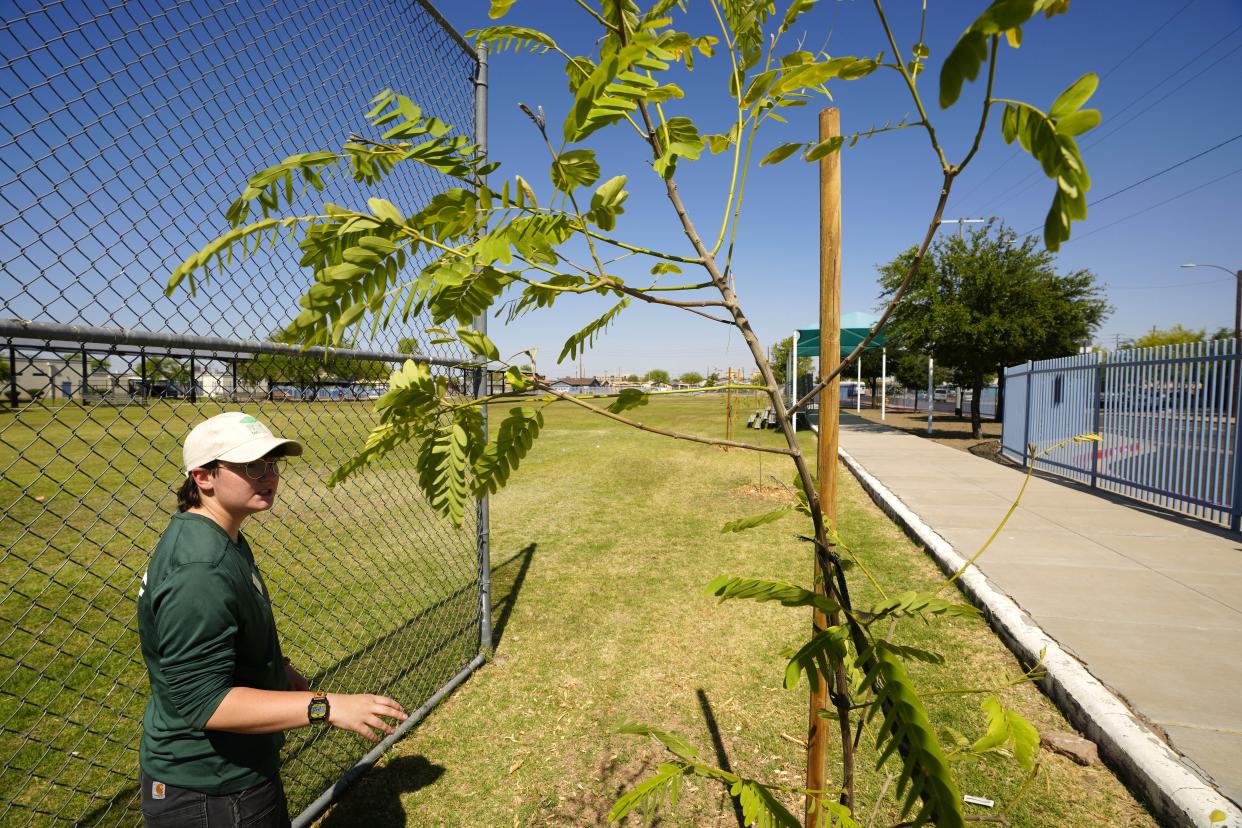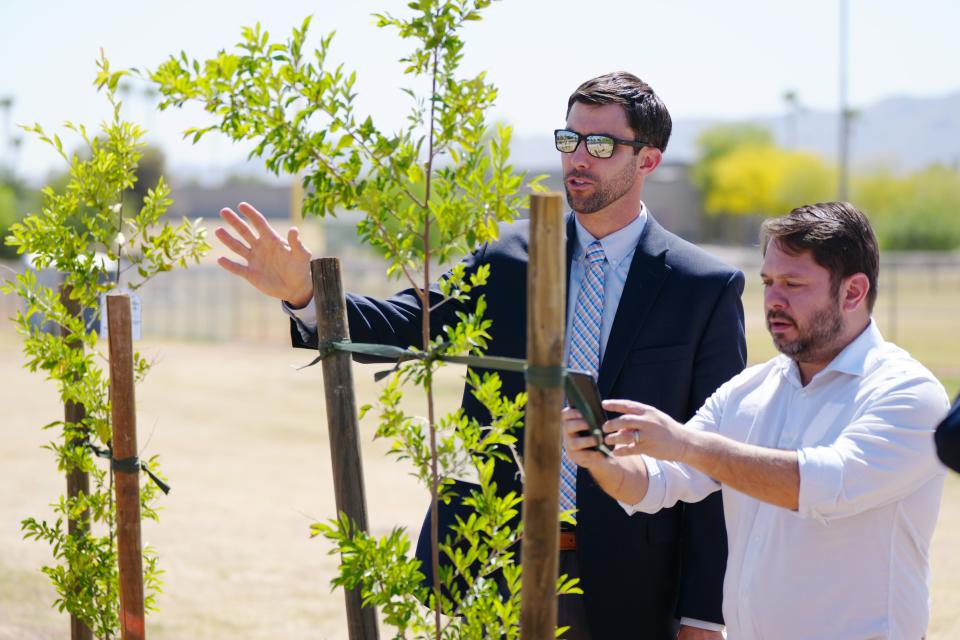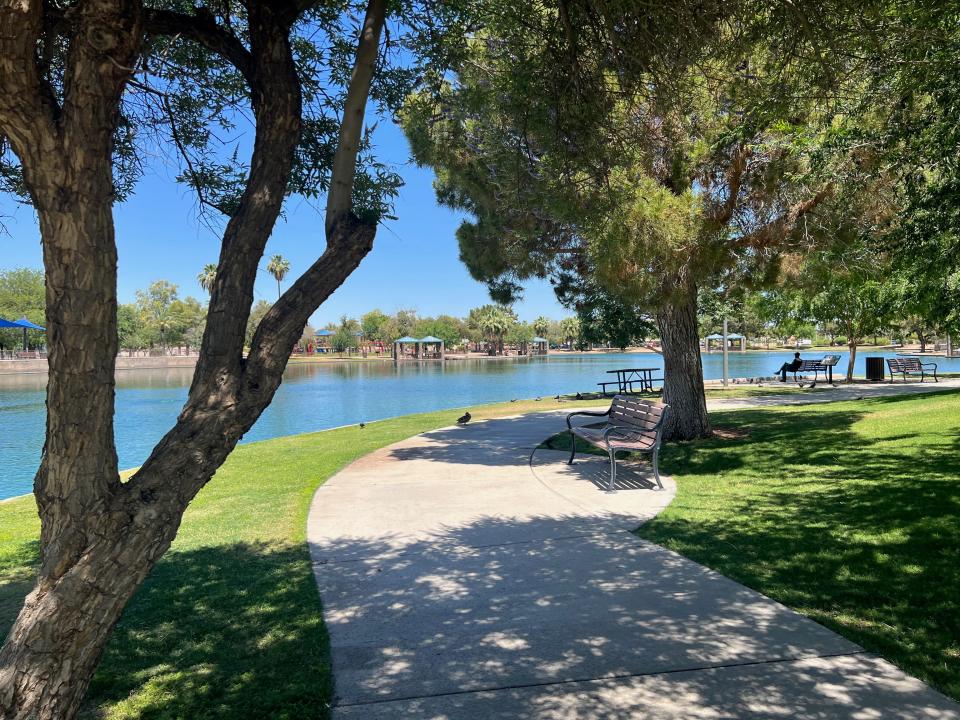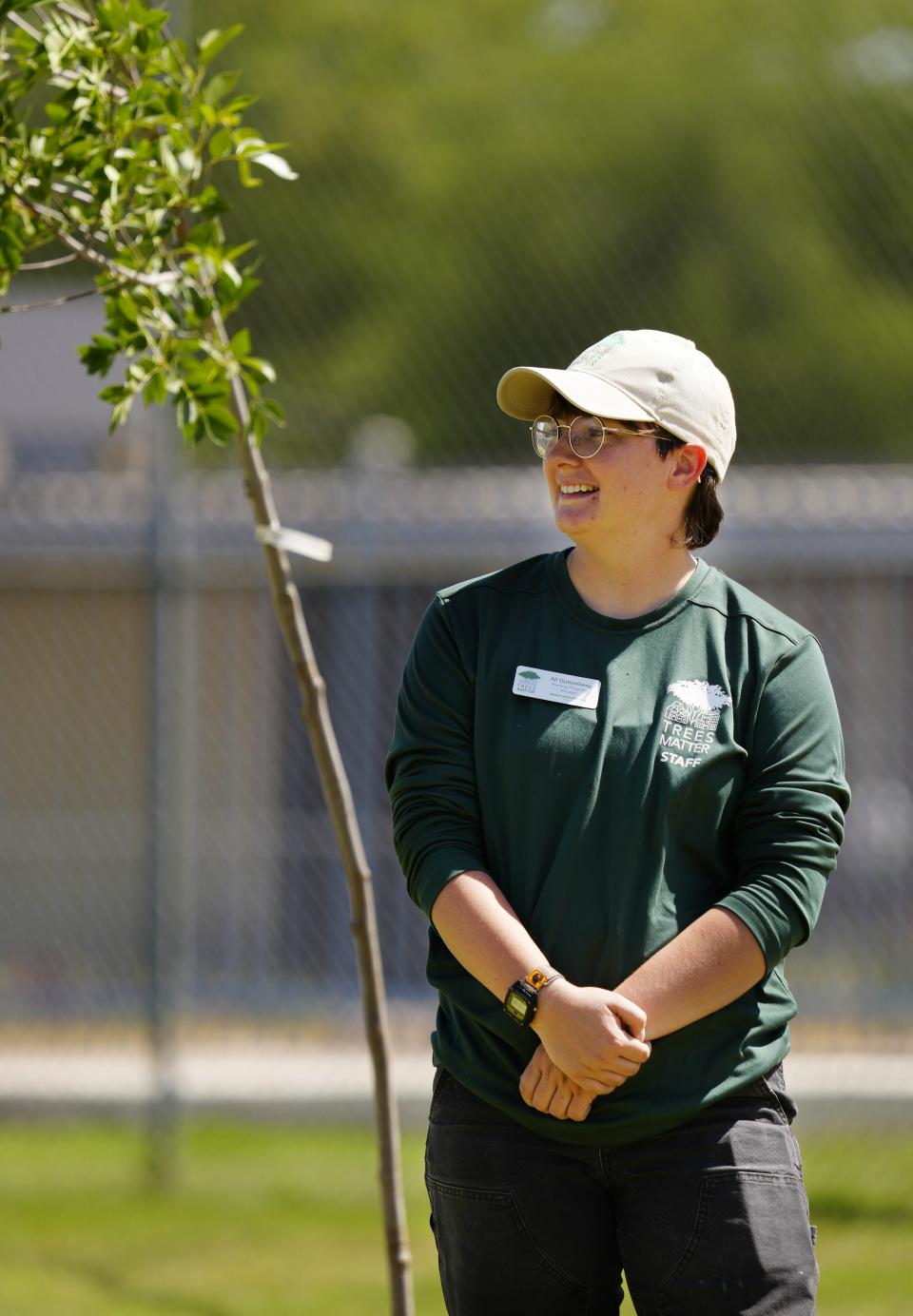Big data and a money tree: How Phoenix decides where to create more shade

Sixty miles east of Winslow, on the windswept plains of the Painted Desert, maroon-colored Triassic fossils recall a forest more than 200 million years old. Felled logs of the ancient conifer species that has since been named Araucarioxylon arizonicum by humans, but which bedecked these lands before the time of dinosaurs, glint in the sunlight in their modern, crystal form.
When these "rainbow wood" remains, now protected as Petrified Forest National Park, were created by minerals seeping in to replace the tissue of buried trees, Arizona was a very different place, climatologically-speaking. Located near the equator on the conglomerate continent of Pangea, it was swampy and infernal, with high volcanic activity and resulting atmospheric carbon dioxide concentrations 10 times higher than today's. But it worked for the lizard-like animals and early mammals that roamed the planet at the time.
Since then, Earth's climate has undergone additional natural and human-caused changes that determine Arizona's habitability for various species. While towering, slender-branched A. arizonicum no longer grace the state's landscapes, current climate warming is motivating renewed enthusiasm for trees.
In the wake of summer temperatures that broke dozens of heat records across the state and contributed to the early deaths of hundreds of people across Maricopa County, Phoenix received $10 million in federal funds through President Joe Biden's Inflation Reduction Act to support tree planting efforts in vulnerable areas. That's on top of $4 million from the American Rescue Plan Act the city allocated toward urban tree shade in 2022, plus $300,000 earmarked by Gov. Katie Hobbs in last year's state budget for the "Trees for Kids" program to create shade at schools.
Funds for trees: 'You had me at trees': An easy fix for Arizona school shade takes root. But will it grow?
Tucson, Mesa, Chandler, Peoria and others also received large sums of money from the U.S. Forest Service in September as part of Biden's $1.5 billion urban forestry initiative, which is also part of his Justice40 plan to address the ways climate change will affect minorities and disadvantaged communities the most.
Now the question facing city planners in each of these places is where exactly to put millions of dollars worth of trees to maximize Arizona's habitability for diverse humans?
Seeing the solution from space
As heat waves and high temperatures become steadily more extreme due to the influences of climate change and urbanization, more parts of the world are navigating the same issue of how best to bring tree shade back onto denuded landscapes to foster a more equitable, livable future for people. Satellite imagery and demographic data are coming to their aid.
Organizations like American Forests, the oldest national conservation nonprofit in the United States, share the goal of reforesting the country as a way to create relief from high temperatures, capture excess carbon emissions warming the planet, address social investment inequities and racist housing practices that left many minority neighborhoods less shaded, and take back some of the habitat converted by wildfire and development.
They've created a free "Tree Equity Score tool" that combines an assessment of neighborhood-level canopy cover sourced from aerial imagery with information about that area's average surface temperatures, income, employment rates, race, age, language and health factors.
Tree Equity Scores in Phoenix currently range from a perfect 100 in the northeastern parts of the valley near whiter, wealthier Scottsdale and Paradise Valley, to scores in the low 60s in neighborhoods to the south and west of downtown, where incomes are lower and the prevalence of Latino residents is higher. That difference not only matters in terms of home values, utility bills and pedestrian comfort, but can be seen reflected in a 2022 heat death map of Maricopa County.
David Hondula, who directs Phoenix's Office of Heat Response and Mitigation and does research on heat impacts with Arizona State University, said his team uses American Forests' Tree Equity Score to help visualize shade variability across the city and target priority areas for more plantings. The online tool has assigned the Phoenix area a goal of 15% canopy cover, he noted, reflecting naturally lower tree densities expected in desert environments. Scores of 100, shown in a teal green on a map of Tree Equity Scores, indicate parts of the city that are sufficiently treed, according to American Forests.
"Let's say there are two neighborhoods that both have a goal in the (American Forest) system of 15% that are at 10% right now," Hondula said. "The neighborhood that has more other indicators of social disadvantage: higher percentage of people in poverty, higher percentage of elderly and some other metrics in their scoring algorithm, gets prioritized. That gives us the framework or structure to talk about differential targets for tree and shade coverage across different use cases."
But even given new data tools, funding and a whole office focused on heat and shade, the city is still a long way from attaining widespread tree equity. And it's nowhere close to reaching its own more ambitious reforestation goal of 25% canopy cover by 2030, laid out 14 years ago in its 2010 Tree and Shade Master Plan.
American Forests estimates average tree cover in Phoenix is currently at 11.8%, with the block groups where the most residents of color live at closer to 9%. The tool calculates the city will need to plant 840,689 more trees to get all block groups to 15% coverage, with untold more required to reach 25%.
Bills for trees: Environmentalists grow frustrated as lawmakers cast shade on bills instead of schools
Hondula is aware of this gap, and hopes increased attention to the need for shade in this rapidly-warming urban environment, plus a revised Tree and Shade Master Plan draft due to city council in April, will help his office get closer to that goal while also shifting it to focus on planting trees more equitably.
“We hear in public engagement and in other planning documents that shade for pedestrians is really important," he said. "People want to feel comfortable and safer as they walk through the city. I think there’s a reasonable chance that will emerge as some sort of high-level priority or strategy in the new plan. We've learned so much since 2010."

Boots on the ground keep roots in the ground
An important source of the learning achieved since Phoenix laid out its 25% shade goal in 2010 comes not from new data-driven technologies, but from good old-fashioned community knowledge.
An aerial map of tree coverage might show a need for more plantings in barren, industrialized zones where people don't really live, walk or work outside, Hondula said. If the city were simply pursuing a goal of maximizing coverage in the valley to boost that overall American Forest canopy score, these regions offer some examples of relatively easy places to go stick saplings in the ground, since there are fewer homes, stores, streets and sidewalks to present right-of-way or construction obstacles.
But he wants Phoenix's forthcoming Tree and Shade Master Plan to take a more nuanced approach to placing trees, which has to start with going back to some basics. One challenge has been getting enough funding to do the on-the-ground surveys needed to design a smart, updated plan, even as money for new plantings rolls in. The last citywide tree inventory was completed in 2014, he said, and a recent quote suggests a new one would be a "mid-six-figure project," since it requires professional, certified arborists to inspect the health of existing trees.
"In some ways we're super blessed with data and analytical capabilities. In other ways, we still have a desperate need to update the citywide tree inventory in terms of the counts of trees on public property," Hondula said. "I think some people think it's this super simple thing of 'just go count the trees' that we're behind on, while we have all this sophisticated change detection and we're slicing and dicing data in all sorts of interesting ways."
Desert plants: 'AZ Plant Lady' writes book on desert gardening with more than cactus and rocks
Despite that slicing and dicing, the overall tree canopy cover in the metro area has barely changed in recent decades. That might be partly due to the unique tangles of the desert environment. With regional water cuts and soaring temperatures, the success rate of newly planted trees can be lower in Phoenix than in other cities, Hondula said.
A common lack of funding for irrigation and maintenance in many tree-planting initiatives doesn't help. Many allocate funds for purchasing trees and getting them in the ground but leave them to find their own water in the desert after that. This was the case with the $300,000 Gov. Hobbs allocated for planting trees at schools in 2023.

The quantity and quality of a natural understanding
The Arbor Day Foundation is another national nonprofit using a blend of data and local expertise to help increase forest cover across the United States. Lauren Marshall, the organization's senior manager of program innovation, explained how they are working with the company NatureQuant to measure the amount and quality of natural features in different neighborhoods using aerial imagery and distribute this information to local planting partners.
NatureQuant doesn't share its data as openly as American Forests, but users can type in individual addresses and get a "NatureScore" indication of how the surrounding greenery compares to other locations. NatureScore values in Phoenix range from single digits to mid-50s, since the company doesn't calibrate expected values to the desert context. But Marshall thinks they can be useful to communities wanting to use tree-planting efforts to alleviate racial, economic and heat disparities, when that information is combined with on-the-ground expertise.
“The local community or local residents are going to be the ones to say ‘there is not enough water here to support that many trees,'" Marshall said. “Data and technology can tell us by a score this is really important, but it’s also really critical to talk about whether or not that’s viable for where you are."
Placing trees is an equity issue on multiple fronts, Marshall said, because if you fund plantings in a lower-income neighborhood and then walk away, that community might not have the resources to maintain them or pay for increased water bills. Then tree removal becomes another expense.
Read our climate series: The latest from Joan Meiners at azcentral, a column on climate change that publishes weekly
The small, Phoenix-based nonprofit Trees Matter is an example of the boots-on-the-ground counterbalance to the big data, big money approach. The Arbor Day Foundation mentioned the group as a local partner in efforts to leverage NatureQuant data to design smarter planting plans. But the folks at Trees Matter prefer to just get out into neighborhoods and get their hands dirty in the soil.
In 2023, Trees Matter planted 189 trees at nine different schools and 69 more across three different residential projects, said Ali Guttenberg, the organization's planting programs manager. The funding comes mostly from small grants from the Arbor Day Foundation, community partners, corporate groups and local utility companies.
Guttenberg said a lot of the work she does involves going into communities to talk about the benefits of trees, which research has shown go beyond heat mitigation and are linked to lower crime rates and improved health. Still, the efforts are not always welcomed in the neighborhoods identified as having the greatest need.
“Sometimes people think it’s a scam and it takes actually seeing us planting trees to realize, 'oh, yeah that actually was (an offer for) free trees,'” Guttenberg said.

With a small staff, Trees Matter must also rely on soliciting applications and matching those requests with available funds, rather than seeking out the best possible locations to address tree shade inequities. The group works with the recipients to select tree varieties, advocating for native species but understanding that sometimes the spiky, scraggly, desert-adapted plants aren't the best fit for school yards where children are playing. These specifications, combined with the fact that Guttenberg said the group doesn't currently have a way to offer recipients help paying for irrigation installation or increased water bills, can limit where and how fast the group can make a difference.
"It’s kind of about trying to find a balance between giving them what they want, trying to put the right tree in the right place and making sure they’re as set up for success as they can be,” she said.
It would not be wise for modern Arizonans to attempt to restore the towering canopies of Araucarioxylon arizonicum, or the scorching, high-carbon climate conditions of the Late Triassic. But with the recent influx of money, analytical tools and local action focused on planting more tree shade across its desert cityscapes, a new, more livable forested era may still lie ahead for the state.
Joan Meiners is the climate news and storytelling reporter at The Arizona Republic and azcentral.com. Before becoming a journalist, she completed a doctorate in ecology. Follow Joan on Twitter at @beecycles or email her at joan.meiners@arizonarepublic.com. Read more of her coverage at environment.azcentral.com.
Sign up for AZ Climate, The Republic's weekly climate and environment newsletter.
Support climate coverage and local journalism by subscribing to azcentral.com at this link.
This article originally appeared on Arizona Republic: How Phoenix decides where to plant more tree shade

